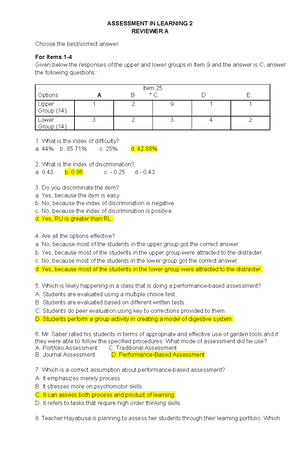- Information
- AI Chat
Was this document helpful?
Appropriate Methods of Assessments
Course: Assessment in Learning 2 (ED 305)
36 Documents
Students shared 36 documents in this course
University: Negros Oriental State University
Was this document helpful?

APPROPRIATE METHODS OF ASSESSMENT
Three viable ways of assessing affective traits are teacher observation, student self-report, and
peer ratings.
METHODS OF ASSESSING AFFECTIVE TARGETS
There are three considerations in assessing affective targets (Blogasiaph, 2019):
1. Feelings and emotions change quickly, particularly in young children and during early
adolescence. It is necessary to perform multiple tests over a period of time in order to
provide a valid indicator of a particular student's emotion or feeling. A single assessment
is insufficient to determine the prevalent affect.
2. Use as many different approaches in measuring the same affective traits as possible. It is
preferable not to focus on a single approach due to its inherent limitations. Students' self-
reports can be falsified, tainting the findings considerably. (However, if the self-reports
match the teacher's observations, a stronger argument may be made.)
3. Determine the kind of data or results needed. Is it individual or group data? The method
to be used will be influenced by the purpose of the evaluation. Individual student
information is used for documenting or providing feedback to parents or other interested
individuals about the learner. Outcomes for groups or the whole class are preferable if
the aim of the evaluations is to enhance instruction.
TEACHER OBSERVATION
The first step in using observation is to decide how individual behaviors apply to the target. It
begins with a vivid description of the trait, then moves on to a list of positive and negative student
behaviors. Here is an example of student behavior indicating positive and negative attitudes
toward learning
These behaviors serve as the basis for creating guidelines, checklists, and rating scales. Positive
behaviors are referred to as approach behaviors, and negative behaviors are referred to as
avoidance behaviors. After developing the list of behaviors, the teacher must determine whether
to conduct an informal, unstructured observation or a formal, structured observation.
➢ Unstructured observation (anecdotal) may be used to make summative judgments.
This is mostly left open-ended; no checklists or rating scales are used. Unstructured
observation is more practical, as teachers can record anything, they observe rather
than being constrained by what is on a checklist or ranking scale.
➢ In structured observation, more time is required since checklists or rating forms must
be created to be used to document observations. To make documenting easier and
more convenient, the form is created from a list of positive and negative behaviors.





